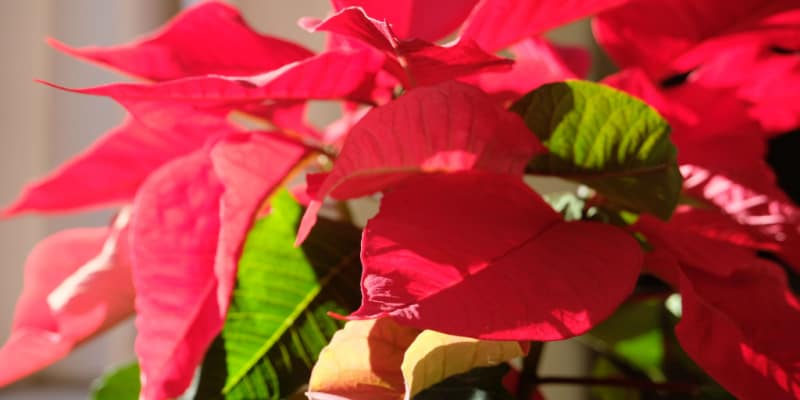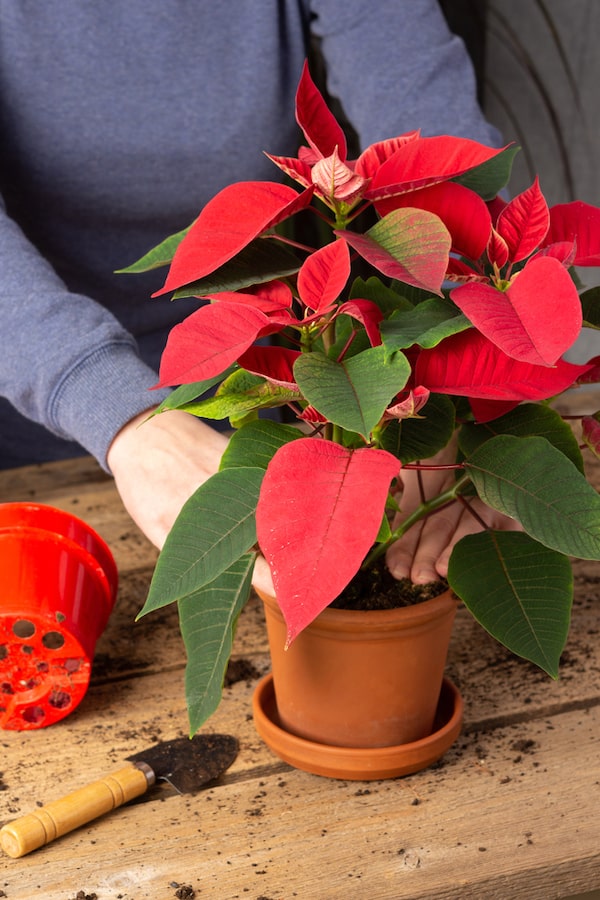
Why are my poinsettia leaves curling?
Our site is reader supported, this means we may earn a small commission from Amazon and other affiliates when you buy through links on our site.
Poinsettia leaves curling is usually a reaction to an environmental problem usually related to watering and temperatures. This is good news as these problems are easily solved, and your poinsettia should return to good health.
Over-watering
If your poinsettia leaves are curling downwards, the most probable cause is over-watering. While these plants like a moist environment, they don’t like being in standing water. If the soil becomes overly damp, the oxygen availability decreases and the roots can’t absorb what water there is. The lower leaves in particular become yellow and start to wilt, curling downwards to keep in whatever water it has. The leaves may eventually fall off.
Water the poinsettia only when the top surface of the soil becomes dry.
Not enough drainage
Make sure the excess water from watering drains out of the pot, leaving the soil moist but not wet. And remove the decorative foil from around the plant or poke holes in it to let the excess water drain out.
If your soil is completely waterlogged, repot the plant into a pot of completely new and dry soil and start over again.
Not humid enough
Winter time tends to be a dry season, especially indoors with the central heating on. While poinsettias don’t like wet environments, they are fond of moist ones. You can increase the humidity around the plant by lightly misting it with water from a spray bottle. But use warm water so as not to shock the plant with cold water. Don’t leave excess water running off the leaves as that sets up a welcoming environment for diseases, especially fungal ones.
An alternative way of increasing the humidity around the plant is to use a pebble tray. Put a tray of pebbles or gravel underneath the plant. Pour in 3cm or so of water or let the excess water from watering the plant drain into the tray. This creates a humid environment around the poinsettia.
Cold temperatures
Poinsettia are tropical plants and can’t deal with cold temperatures, either during the day or during the night. Even a slight breeze from a partially open window across the room can cause stress for the plant. Leaf curl can be a symptom of cold shock.
Check the location of your poinsettia. Is it near a leaky window? Or perhaps an air conditioning vent? Or across the room from a frequently used door?
Move your plant to a more sheltered location, out of the way of any potential cold or even cool draft. And if it’s on a window sill, be sure not to pull the curtains over it at night time, leaving it in the cold zone between the curtains and the window.
Not enough light
Poinsettias need six or more hours of sunlight a day. Without enough sunlight to support the needed photosynthesis, the plant goes into stress mode, and the leaves curl. Sunlight needs to reach the green leaves. Not enough sunlight or too much direct sunlight causes problems within the plant. The leaves then curl to slow down the rate of moisture loss.
You may notice that only one side of your poinsettia has curling leaves. This is the side that doesn’t get enough sunlight. Turn the plant so that this side is in the sunlight and things should even themselves out.
Over-fertilising
If you’re just keeping your poinsettia for one holiday season, then you don’t need to fertilise it at all. However, if you plan on re-blooming it the next winter, there’s an entire process to follow, including fertilising. (See How to get poinsettias to turn red again for details.) Within this process, you may be over-fertilising your plant, and that’s causing enough stress for the leaves to curl up. The bigger leaves start to curl up first as the younger leaves further along the plant hog all the fertiliser as they grow fast.
It might also be worth looking for pests and diseases. Also, have a read of this guide if you have yellowing and wilting leaves.
I also have a guide on caring for poinsettias as well as a guide here on why your poinsettia might be dropping its leaves.
